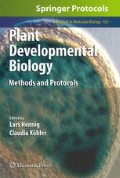Abstract
In plants, gametes are formed in multicellular haploid structures, termed gametophytes. The female gametophyte of most higher plants comprises seven cells, which develop from a single haploid spore through nuclear proliferation and subsequent cellularization. The female gametophytic cells differentiate into four distinct cell types, which play specific roles during fertilization and seed formation thereby ensuring reproductive success. In recent years many new techniques and cell type-specific marker lines have been established, making the female gametophyte an attractive system to study mechanisms of reproduction as well as cell specification. The following chapter describes a basic protocol for, first of all, recognizing a female gametophytic mutant and subsequently analyzing the phenotype on a morphological, molecular, and functional level.
Access this chapter
Tax calculation will be finalised at checkout
Purchases are for personal use only
References
Boisson-Dernier, A., Frietsch, S., Kim, T., Dizon, M. B., and Schroeder, J. I. (2008) The Peroxin Loss-of-Function Mutation abstinence by mutual consent Disrupts Male-Female Gametophyte Recognition. Curr Biol 18, 63–68.
Capron, A., Gourgues, M., Neiva, L. S., Faure, J., Berger, F., Pagnussat, G., Krishnan, A., Alvarez-Mejia, C., Vielle-Calzada, J. P., Lee, Y. R., Liu, B., and Sundaresan, V. (2008) Maternal control of male-gamete delivery in Arabidopsis involves a putative GPI-anchored protein encoded by the LORELEI Gene. Plant Cell 20, 3038–3049.
Christensen, C. A., King, E. J., Jordan, J. R., and Drews, G. N. (1997) Megagametogenesis in Arabidopsis wild type and the gf mutant. Sex Plant Reprod 10, 49–64.
Gross-Hardt, R., Kägi, C., Baumann, N., Moore, J. M., Baskar, R., Gagliano, W. B., Jürgens, G., and Grossniklaus, U. (2007) LACHESIS restricts gametic cell fate in the female gametophyte of Arabidopsis. PLoS Biol 5, e47
Howden, R., Park, S. K., Moore, J. M., Orme, J., Grossniklaus, U., and Twell, D. (1998) Selection of T-DNA-tagged male and female gametophytic mutants by segregation distortion in Arabidopsis. Genetics 149, 621–631.
Huck, N., Moore, J. M., Federer, M., and Grossniklaus, U. (2003) The Arabidopsis mutant feronia disrupts the female gametophytic control of pollen tube reception. Development 130, 2149–2159.
Ingouff, M., Hamamura, Y., Gourgues, M., Higashiyama, T., and Berger, F. (2007) Distinct dynamics of HISTONE3 variants between the two fertilization products in plants. Curr Biol 17, 1032–1037
Ingouff, M., Jullien, P. E., and Berger, F. (2006) The female gametophyte and the endosperm control cell proliferation and differentiation of the seed coat in Arabidopsis. Plant Cell 18, 3491–3501.
Joshua, G., Steffen, J. G., Kang, I., Macfarlane, J., and Drews, G. N. (2007) Identification of genes expressed in the Arabidopsis female gametophyte. Plant J 51, 281–292.
Kägi, C. and Groß-Hardt, R. (2007) How females become complex: Cell differentiation in the gametophyte. Curr Opin Plant Biol 10, 633–638.
Luo, M., Bilodeau, P., Dennis, E. S., Peacock, W. J., and Chaudhury, A. (2000) Expression and parent-of-origin effects for FIS2, MEA, and FIE in the endosperm and embryo of developing Arabidopsis seeds. Proc Natl Acad USA 12, 10637–10642.
Moll, C., von Lyncker, L., Zimmermann, S., Kägi, C., Baumann, N., Twell, Grossniklaus, U., and Gross-Hardt R. (2008) CLO/GFA1 and ATO are novel regulators of gametic cell fate in plants. Plant J 56, 913–921.
Nowack, M. K., Grini, P. E., Jakoby, M. J., Lafos, M., Koncz, C., and Schnittger, A. (2006) A positive signal from the fertilization of the egg cell sets off endosperm proliferation in angiosperm embryogenesis. Nat Genet 38, 63–67.
Page, D. R. and Grossniklaus, U. (2002) The art and design of genetic screens: Arabidopsis thaliana. Nat Rev Genet 3,124–136.
Pagnussat, G. C., Yu, H., and Sundaresan, V. (2007) Cell-fate switch of synergid to egg cell in Arabidopsis eostre mutant embryo sacs arises from misexpression of the BEL1-like homeodomain gene BLH1. Plant Cell 19, 3578–3592.
Pagnussat, G. C., Yu, H., Ngo, Q. A., Rajani, S., Mayalagu, S., Johnson, C. S., Capron, A., Xie, L. F., Ye, D., and Sundaresan, V. (2005) Genetic and molecular identification of genes required for female gametophyte development and function in Arabidopsis. Development 132, 603–614.
Portereiko, M. F., Lloyd, A., Steffen, J. G., Punwani, J. A., Otsuga, D., and Drews G. N (2006) AGL80 is required for central cell and endosperm development in Arabidopsis. Plant Cell 18, 1862–1872.
Sandaklie-Nikolova, L., Palanivelu, R., King, E. J., Copenhaver, G. P., and Drews, G. N. (2007) Synergid cell death in Arabidopsis is triggered following direct interaction with the pollen tube. Plant Physiol 144, 1753–1762.
Steffen, J. G., Kang, I. H., Portereiko, M. F., Lloyd, A., and Drews, G. N. (2008) AGL61 interacts with AGL80 and is required for central cell development in Arabidopsis. Plant Physiol 148, 259–268.
Yadegari, R. and Drews, G. N. (2004) Female gametophyte development. Plant Cell 16, 133–141.
Yadegari, R., Paiva, G., Laux, T., Koltunow, A. M., Apuya, N., Zimmerman, J. L., Fischer, R. L, Harada, J. J., and Goldberg, R. B. (1994) Cell differentiation and morphogenesis are uncoupled in Arabidopsis raspberry embryos. Plant Cell 6, 1713–1729.
Yu, H. J., Hogan, P., and Sundaresan, V. (2005) Analysis of the female gametophyte transcriptome of Arabidopsis by comparative expression profiling. Plant Physiol 139, 1853–1869.
Acknowledgments
The authors would like to thank F. de Courcy and members of the Gross-Hardt laboratory for critical reading of the manuscript. Work in the Gross-Hardt laboratory is supported by grants from the Deutsche Forschungsgemeinschaft (DFG).
Author information
Authors and Affiliations
Editor information
Editors and Affiliations
Rights and permissions
Copyright information
© 2010 Springer Science+Business Media, LLC
About this protocol
Cite this protocol
Völz, R., Groß-Hardt, R. (2010). Female Gametophytic Mutants: Diagnosis and Characterization. In: Hennig, L., Köhler, C. (eds) Plant Developmental Biology. Methods in Molecular Biology, vol 655. Humana Press, Totowa, NJ. https://doi.org/10.1007/978-1-60761-765-5_10
Download citation
DOI: https://doi.org/10.1007/978-1-60761-765-5_10
Published:
Publisher Name: Humana Press, Totowa, NJ
Print ISBN: 978-1-60761-764-8
Online ISBN: 978-1-60761-765-5
eBook Packages: Springer Protocols

